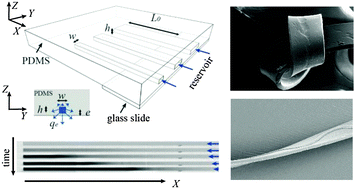Investigation of the dynamics of growth of polymer materials obtained by combined pervaporation and micro-moulding†
Abstract
We report an extensive study of the concentration process of aqueous polymer solutions confined within microfluidic channels, owing to the pervaporation of water through the matrix of the chip. Concentration of polymer continuously increases up to the formation of a dense material which eventually invades the channel. This technology can be used to fabricate micro-composites of different shapes starting from dilute inks. We use both theory and screening experiments to show that the dynamics of growth can be predicted by simple conservation equations. More precisely, we establish a quantitative prediction of the growth dynamics taking into account deformations of the soft channels of the moulds, and the solvent chemical activity of the polymer solution. The present results based on general transport equations for binary mixtures provide direct guidance for the design of micro-fabricated materials considering their shape, dimensions, time scale of fabrication, and chemical composition. This quantitative framework is indeed essential to engineer integrated polymer-based micro-devices by using combined pervaporation and microfluidic moulding.


 Please wait while we load your content...
Please wait while we load your content...